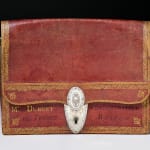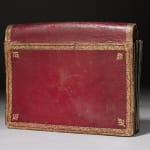Pierre-Joseph Bisiaux (in the style of)
Further images
Provenance
Formerly part of the collection of Joseph Duruey, administrateur du Trésor royal (1741-1794).
Thence to a European private collection.
Sold by Christie’s Paris, 2nd June 2005, lot 180.
Until recently in a private collection, Switzerland.
An important Louis XVI red Moroccan leather portefeuille with gilt tooling in the style of Pierre-Joseph Bisiaux originally belonging to Joseph Duruey, embossed on the lower front in gilt lettering MR DURUEY ADMINISTRATEUR DU TRESOR ROYAL and stamped on the oval escutcheon plate with the Duruey family crest. Of rectangular outline, the front shaped flap centred by an engraved silver oval escutcheon bearing the Duruey family crest within a decorative border, the red leather decorated on both the front and the back with a running gilt tooled border composed of an entwined meandering floral and foliate band and with floral and foliate spandrels at each corner, the interior divided into several sections lined with gold tooled green leather. Accompanied by its original key
Paris, circa 1790
Height 22.5 cm, width 29.5 cm.
With its red Moroccan leather, finely tooled with gold banding and sporting both the Duruey crest on the silver escutcheon as well as Joseph Duruey’s name and role as administrator of the Royal Treasury under King Louis XVI, this delicate portefeuille or portfolio is of significant historical importance. Sadly like the king, Duruey was one of the many victims of the French Revolution when he was guillotined in Paris on 18th March 1794. Recognising its importance, his family would have carefully kept the portefeuille which stands as testament to his role in maintaining the royal finances during the latter part of Louis XVI’s reign.
The grandson of Edmé Duruey, coachman to the duc de Mecklembourg and son of Pierre Duruey and his wife Anne d’Anne Nicole Loignon de Beaupré, Joseph Duruey was born in Paris on 20th December 1741 and baptised there three days later. In 1781 he was appointed secrétaire du Roi and then in 1783 Général des Finances de la Généralité de Poitiers. This was followed by his appointment in 1787 to the court at Versailles as treasurer of foreign affairs and banquier de la cour. From 1787 until 1792 he acted as director of the Caisse d’Escompte and in 1790 was appointed the role of administrateur du Trésor royal, as is described on the present portefeuille.
In July 1767 Joseph Duruey married Jeanne Morin with whom he had two daughters. In 1790, the same year that he was appointed royal treasurer, he and his wife bought château de Mortefontaine in the Oise but following his execution in 1794 it was confiscated by the state and was subsequently acquired four years later by Joseph Bonaparte, brother of the First Consul.
Duruey may have avaded execution if he had not been discovered to have aided Louis XVI in his plan to go into exile. In 1791 the king told Duruey of his plans and thus Duruey lent him the sum of 3,200,000 livres. Initially, when the king’s attempts were aborted, Duruey’s part in the plan was not disclosed. However, a hiding place in the king’s apartments at the Palais des Tuileries was then discovered and in it was correspondence between the king and Duruey, Mirabeau and many others who were all subsequently found guilty by the Revolutionary government.
The gilt tooled decorative border compares very closely to the work of Pierre-Joseph Bisiaux (c. 1750-1811) who was one of the leading Parisian book binders at the end of the eighteenth century. Among almost identical borders are two black goatskin bound books by Bisiaux in the British Museum, London, one a copy of “Hesiodi Ascraei quæcumque exstant, Græce et Latine, ex recensione J. Clerici, cum ejusdem animadversionibus” by Hesiod and the other “Della risurrettione de’ morti, tradotto...da Girolamo Falet” by Athenagoras Atheniense. Received as a maître in May 1777, Bisiaux worked for the Countess du Barry, Pierre Caron Beaumarchais as well as the bookseller and publisher Antoine-Augustin Renouard. Bisiaux and his rival Bradel l’aine (fl.1770-1795) were leaders in their trade during the transition period from the Monarchy to the Directory. He is mainly known for his Neo-classical styled borders that he himself called ‘English’. For this purpose, he had many ornate wheels (such as stylized foliage drawings or geometric figures), in different widths, which he used separately or in combination. During his career he was established at place Maubert, at the sign of Mont-Saint-Michel, 1777-87, then circa 1787 at 32 rue du Foin, at 1 rue des Carmes 1799-1801 and finally at 12 rue Contrescarpe, 1801-11.





